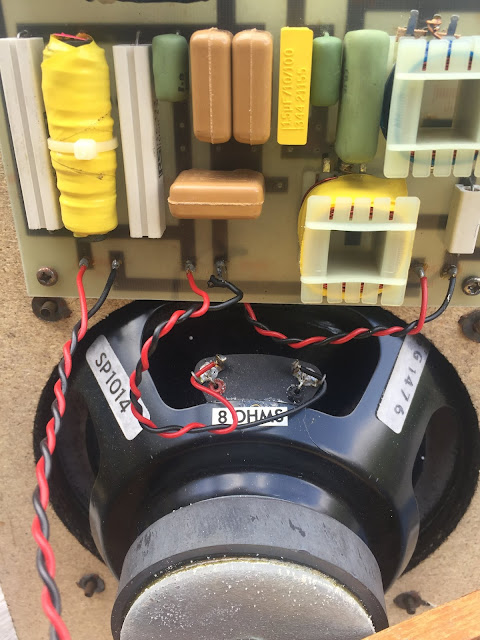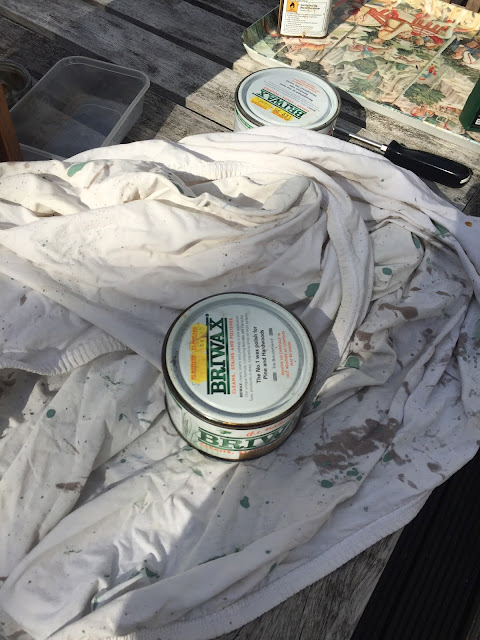I routinely search ebay for bargain HiFi gear, usually once great brands now rather forgotten.
A recent search yielded a pair of scruffy looking speakers but I recognised the old name of Audiomaster. They had been one of the 50+ UK speaker manufacturers that existed during the 1970's into the 1980's along with the likes of Tangent, RAM , griffin etc. Audiomaster were one of the first brands awarded the LS3/5a licence - the right to make speakers to that BBC specification, no mean accolade.


The speakers in question were in a poor state, the tweeter looked heavily corroded, the bass unit had tears in the rubber surround, there were no grilles and the cabinets were quite scratched, but the seller made this all very clear. I put in a very low bid, and won them for £3. Collected from the nearby Town and the seller was great, collected and set about trying to restore them.
First off after a bit of research I think these are Audiomaster Image Two speakers. The complex crossover have Image One etched on them, but I think the Image two was there only speaker to use a Peerless silk dome tweeter, coupled with the ubiquitous Kef B200 SP1014 bass/mid unit. What intrigued me about these speakers were the complex crossover and the well made cabinets - some thought had gone into these.


When I got them home, it was nice weather so I worked outside on them, first removing the front of the speakers so I could work on the cabinets without risking the drivers. The cabinets were veneered chipboard but well made with damping panels and foam applied to all the internal surfaces, similar to the LS3/5a. Screws held the front Bezel on and was easy to remove. Some of the screwheads showed a little red tint of rust, but otherwise fine. once I had the bezel off, I needed to unsolder the wires from the crossover board to the speaker terminals at the back of the speaker, and to each driver.
I wasn't absolutely sure they even worked, the seller said they did though they buzzed due to the busted rubber surrounds on the B200 units. the B200's were unscrewed and their wires unsoldered from the crossover. The surrounds were badly split and one had a cracked cone. Using a multimeter set to resistance I was able to measure across both drivers and they returned a 7.2Ohm value, indicating that both coils were complete. Similarly the Peerless tweeters, glued in place with mastic, measured a resistance, so I was hopeful they worked.
I managed to get the front of the tweeters looking better using a little White Vinegar on a rag, carefully avoiding the soft silk dome. The vinegar got rid of the white Aluminium Oxide corrosion, just leaving exposed metal ,

One cabinet also showed signs of one of the corner seams opening, so I applied some wood glue along the seam, forcing it into the gap then clamped the whole thing using a car strap, and some cardboard to take the strain


Then in one of those magical moments, a friend Dylan from the wonderful facebook group audioshite (dedicated to the promotion and restoration of old audio equipment) reminded me he had a similar pair of speakers from Tangent. These he'd won on ebay, but the cabinets had been smashed by the delivery agent. They contained a working pair of B200's and so a plan evolved where he had the speakers, and we dropped them off with him. It was right that he had them
"They just do everything, really nicely and every so often they take me by surprise and make me grin. I've heard SP1014s before in various boxes, and they've always given me the impression that they're working really hard. They just feel somehow more free in these boxes. I don't know what the crossover frequency is but I wonder if it's relatively low, leaving the woofers to just do the bits they do best. Most speakers sound dreadful in my living room, which is a nightmare for speaker and ear placement. These sound good everywhere. Even 90 degrees off axis when I'm sitting in the corner at the computer. I don't understand how this is even possible"
So these half-forgotten Classic British speakers from the late 70's are repaired and getting good use again.
Below in their final form, Dylan having further restored them, removing the velcro and repainting the front bezels. Very smart:






Comments